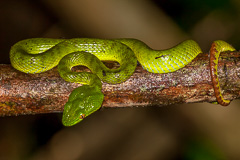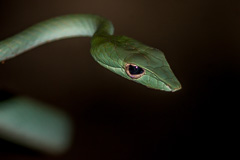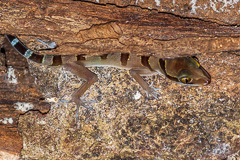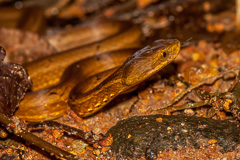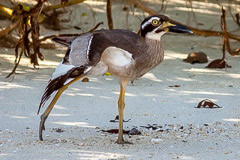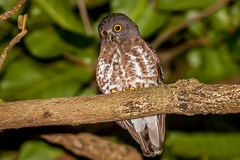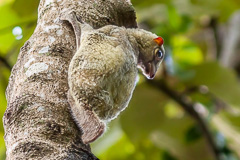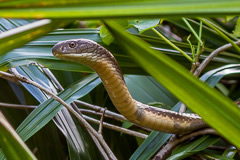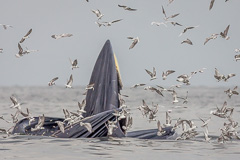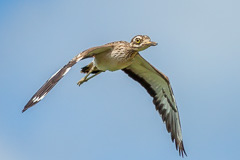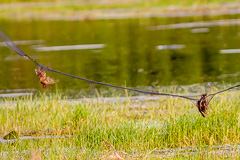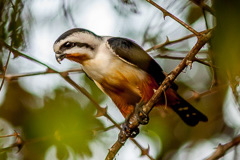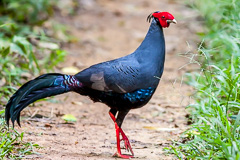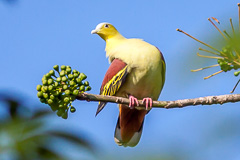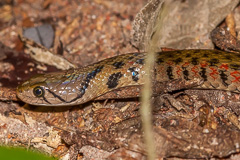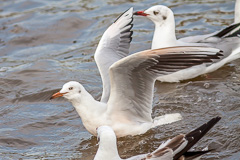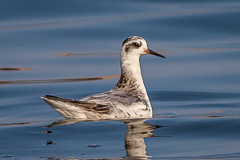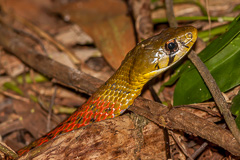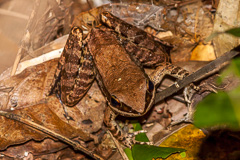Overview
Dates: |
26 Oct - 18 Nov 2014. |
With Ian Dugdale and Games Punjapa Phetsri plus, in parts, Ike Suriwong, Phil Round, Tom Backlund, Andy Pierce and Peter Ericsson. This trip started life, months previously, as a research trip to explore a number of infrequently visited sites as well as targeting a few species we'd not previously found or photographed. Although we had ideas of areas we wished to cover, the itinerary was not fixed in advance as continuing uncertainties over permits and permission to trek in Khao Soi Dao sanctuary meant we had to remain flexible. After a number of early changes in the planning we eventually settled on a route starting in Phuket, and loosely passing Khao Phanombencha, Khao Dinsor, Laem Phak Bia, Bangpoo, Khao Ang Ru Nai and Khao Soi Dao, before heading north to finish in Chiang Mai. We hoped that further opportunities would crop up along the way. This was very much a make-it up-as-we-went-along trip.
24 Oct. Air Asia flight from Chiang Mai to Phuket. Picked up car and drive to Karon, where the only bird of note was a Japanese Sparrowhawk that flew past the beach.
25 Oct. A day of leisure and preparation for tomorrow's pelagic. During an evening beer on the hillsides outside Karon an Oriental Bay Owl heard.
26 Oct. To our knowledge, only a couple of pelagic birding trips had ever been organised out of Phuket, and neither had ventured into deeper water. We pre-organised a sport-fishing boat, through Fishing In Phuket to take us out to the drop-off. We also had large qualities of chum - comprised of a mixture of sardines, fish heads, pork fat, fish sauce and palm oil. With little experience, this was very much an experimental pelagic. Five of us gathered at Chalong pier, loaded the boat and departed shortly after 07:30. The weather forecast was good with sun and calm seas forecast. Unfortunately only 30 minutes out the engine developed serious issues meaning another boat was required, that fortunately came out to join us, so we swapped boats and were underway by about 08:45. We steamed directly west of Phuket for about three and a half hours to the 1,500 metre drop-off, around 40 kilometres out. En route rather quiet with only a single Green Turtle, Indo-Pacific Bottlenose Dolphin, a few Little Tern, a male Christmas Frigatebird, and a few Bridled Tern.
Weather the whole day was amazingly still and calm with the sea as flat as a pancake - not exactly ideal seabirding conditions. At the edge of the drop-off we threw out some chum, but as we'd seen few birds so far we were not optimistic. Having had zero results from the chum, for the rest of the afternoon we decided to steam south along the drop-off toward the Racha islands and then back toward Chalong. Unfortunately, we saw few seabirds, save for more Bridled Tern, Common Tern, White-winged Tern and a few Lesser Frigatebird. However, the day was completely saved when a Streaked Shearwater passed close to the boat and headed off north. An excellent find and something like the sixth Thai record.
27 Sep. Having dropped off Phil at the airport, set off around 10:00 toward Krabi. For our next stop we thought to try the little visited Khao Phanombencha National Park, from where there are at least historic records of Striped Wren-Babbler and Chestnut-capped Thrush - two near mythical species in Thailand. Arrived shortly after 14:00, but rain set in almost immediately, and it wasn't until after 15:00 that we eventually managed to bird the short trails and headquarter area.
Weather wet, dismal and overcast, and when the rain started again at 16:30 we retreated to our park accommodation to watch the rain for a while. Typical national park accommodation - decrepit. lacking maintenance, with fan, cold shower and overpriced. Sadly, several of the accommodation units in this park are beyond repair and falling to pieces. Just after dark the rain ceased, allowing us to take a two hour night walk with one of the rangers. Whilst slow, this produced some excellent finds including Barred Eagle-Owl, a roosting Crow-billed Drongo, Malayan Vine Snake, the stunning Beautiful Bent-toed Gecko and a Thai Peninsula Pit Viper. |
|
28 Oct. Another early walk along the park's limited trail system, with a few birds added, such as Yellow-eared Spiderhunter, Baker's Bulbul and Asian Brown Flycatcher, but generally very quiet and the forest appeared almost devoid of birds. Surprisingly, the Thai Peninsula Pit Viper was still in exactly the same spot.
Drove toward Khao Sok National Park, first attempting the side track to to the Bang Daen substation of Khlong Phanom National Park. However, this was impassible at the first stream crossing, so we continued to the Km 99 Trail of Khao Sok where no sooner had we arrived than the rain started again, necessitating another hour wait for it to ease. At 15:30 we started up the trail and spent the remainder of the afternoon here. But the poor, dismal weather and low cloud kept bird activity to a minimum. This trail is also falling into disuse, and after about a kilometre became mostly overgrown and difficult to navigate. This trail formerly continued about eight kilometres to the lake. In a couple of hours we managed Great Hornbill, Bushy-crested Hornbill, White-bellied Munia and Swinhoe's Minivet. Overnight at the nearby Tawarat Resort, which was pleasant and recommended.
29 Oct. A leisurely start, with a drive to Ratchaprapha Dam, dropping off Games for a three day booking with clients. The remaining two of us drove to Khuraburi, visiting the pier and national park office north of town in order to set up a trip to Mu Ko Surin National Park. Unfortunately, being the very start of the season, no boat was available the next day - only on 31 October - so we needed to fill in a couple of days with some local birding. Found a reasonable roadside resort, grabbed some lunch and decided to visit the area around the Tung Cha-lee ranger sub-station of Sri Phang-nga National Park just east of town. True to form, no sooner had we arrived than the rain started, so another session waiting in the vehicle for the rain to stop followed by another damp walk, through good-looking forest around the sub-station. Best birds of the afternoon were Taiga Flycatcher, White-crowned Hornbill, Forest Wagtail, a single Plume-toed Swiftlet and a group of White-bellied Munia. After dark we took another night walk, which was pretty dire with only Collared Scops Owl and Brown Wood Owl calling and not a single reptile or amphibian.
30 Oct. Back to Cha-lee where we followed a series of tracks into some reasonable forest, only for it to lead to the inevitable rubber plantation - no doubt illegally cleared inside the park boundary. We spent the whole morning here finding a fair collection of interest, including Forest Wagtail, Crow-billed Drongo, Dusky Broadbill, Orange-breasted Trogon, White-crowned Hornbill, Cream-vented Bulbul, Chestnut-winged Babbler and Brown-cheeked Fulvetta. A Mock Viper gave us some real identification headaches which were only subsequently resolved by consulting those more expert in snake identification. |
After lunch, with the rain clouds brewing, we drove around the Khuraburi area seeking other areas of ornithological interest. Just north of town we followed a road to a weir, at the Sri Phang-nga park boundary, that appeared to have a trail along the river. However, heavy rain meant we were unable to explore this further, and earmarked it for future exploration. Next we tried roads west of town into the mangrove areas, ostensibly within the Mu Ko Ra-Ka National Park - again with villages and rubber and oil palm plantations. Eventually found some interesting mangroves, but heavy rain precluded exploration so we headed back to the accommodation, reckoning an early morning session might be profitable. Back in town a group of waders on a large playing field proved to be Pacific Golden Plover, and whilst investigating these, a group of Red-breasted Parakeet were discovered in the surrounding trees - a species decidedly scarce in the south.
31 Oct. We returned to the mangroves at first light, where we found access to a low hill giving a commanding view over an extensive area of mangrove. Unfortunately, as recently cleared and planted with rubber, this view will be gone within a couple of years. We had hoped for any species of green pigeon in early morning flight, but this was not to be. In the first hour of light the best birds were Ruddy Kingfisher and, somewhat surprisingly, Red-breasted Parakeet. Returned to the pier, where at 09:10 we departed on the speedboat to Mu Ko Surin. Seabirding on the crossing was next to impossible due to the speed of the boat, but we did manage to identify Bridled Tern, Black-naped Tern, Greater Crested Tern and Common Tern.
|
|
Having faffed around en route collecting passengers from Ko Phra Thong and dropping off snorkelers, we eventually arrived at Mu Ko Surin late morning where a conversation with one of the park rangers, on the whereabouts of recent sightings of Beach Stone-curlew. assured us they were easy to see and there were many. Hmm, really? Having dipped in the past that was not at all easy to believe! Anyhow, we set out with a longtail boat at 13:00 and steamed over to a small islet to the west, where we sat at the end of the beach in the hope that the birds would come to feed, which they supposedly did quite often. After an hour we gave this up and took the boat for a long trip around Ko Surin Tai island, scanning all the rocks and small bays. After an hour, as we almost arrived back at our starting point, amazingly we spotted a couple of Beach Stone-curlew resting quietly on a small sandy cove. Sitting in the shade at the back of the beaches against the forest, these birds are not at all easy to spot and could easily be passed by. By letting the boat drift with the wind we were able to move close to the birds without disturbing them, obtaining great views - a much sought after species. From here we took the boat to Mai Ngam beach, at the end of the Nature Trail and had the boat drop us off so we could walk back to the campsite. As luck would have it another pair of Beach Stone-curlew were present on this beach. Since our last visit, five years ago, this trail has deteriorated enormously. What used to be a pleasant walk with a few ups and downs has decayed into an obstacle course of fallen trees and undergrowth, and it was a hot, sweaty, hour plus slog through it. As usual, it appears, park (mis)management wishes to deter people from using trails by not maintaining them. Along the way we spent some time in the clearing of the old navy base, that had a few Large Green Pigeon flying over, as well as Green Imperial Pigeon and a couple of Pied Imperial Pigeon. We also found a three metre King Cobra, that was of decided interest, as park staff had said there were none of the island. Arrived back at the campsite just on dusk. At this time of year, at the very start of the season, it was great to be one of the few guests staying, camped on the beach - very peaceful. A night time stroll around the campsite and start of the nature trail gave us Brown Boobook and a couple of unidentified rodents and geckos. 1 Nov. As we'd been successful yesterday with the Beach Stone-curlew, we decided to concentrate on the Large Green Pigeon, so again walked the Nature Assault Trail. At the naval clearing we again had Large Green Pigeon, as well as a few migrants such as Pacific Swift, Asian Brown Flycatcher and Amur Stonechat. We also flushed a single Nicobar Pigeon off the trail, and Plume-toed Swiftlet was a surprise. Arrived back at the campsite in the heat at midday where a brief hunt found the ever present Sunda Colugo near the restaurant. Eventually, back on the speedboat after 15:00, then a four hour drive through heavy rain to Chumphon where we met up with Games again. Next up were a couple of days on Khao Dinsor for any late raptors, especially Short-toed Snake Eagle, one or two of which typically pass late in the season. |
2 Nov. Peering out the window at first light, surprised to see rain and thick cloud - not the best for Khao Dinsor. Undeterred, we drove to the mountain and by 08:00 the rain had largely ceased, so ascended to the first platform. Very windy, with low cloud and rain showers for the first couple of hours, that kept migration activity to a minimum, with only a few Ashy Minivet and Japanese Sparrowhawk passing. Although the rain stopped and the remainder of the day was dry with variable cloud cover, the strong wind from the sea kept all migrants well away from Dinsor. The raptor count for the day was extremely low with only one flock of 18 Black Baza, a couple of Shikra, Common Kestrel and a single Peregrine Falcon. Left around 16:00, with rain starting around 17:30. Overnight as usual at Thung Wua Lean. A evening walk locally found Reticulated Python, Yellow-striped Caecilian and a few frogs. Having been lazy and forgotten umbrellas, we were caught out by heavy rain which curtailed night walking and resulted in a mad dash back to protect equipment.
3 Nov. Similar weather to yesterday initially, though less windy. No sooner had we arrived on the mountain than the rain came down heavily for a while. Once past, the remainder of the morning was calm with cloud and sunny periods which helped raptor migration - at least 1,200 Black Baza as well as a few Grey-faced Buzzard and a flock of White-throated Needletail. Left at 12:00 to drive northward to Phetchaburi. As we had a whale-watching trip planned for tomorrow we tried to find accommodation at the nearby Ban Laem. However, this town appeared to have no accommodation at all, forcing us to return to Phetchaburi to find some.
4 Nov. Heavy rain overnight, but cloudy and cool early morning. Drove to Bang Tabun and met up with Tom and Peter. The five of us boarded the boat and set out to sea heading east-northeast for about 33 kilometres where we encountered our first Bryde's Whale. Good numbers of Common Tern and White-winged Tern were also feeding in the area. The area also held several Pomarine Skua, although obtaining good views was difficult, especially due to the heavy rain that started as soon as we'd found the whales. Over the next couple of hours we had a number of whale sightings, but no further interesting seabirds. Around 14:00 we started to head back, with the rain easing off and a bright day ensuing. Overnight in Phetchaburi again. |
5 Nov. Our main aim today was to find Red Knot at Laem Phak Bia. Although not a rare passage migrant, this species is easily overlooked. Arriving at Pak Thale early morning we found almost no waders present, most likely on account of the low tide meaning that the best feeding was out on the mud flats. This implied the afternoon would be better, so we headed toward Laem Phak Bia stopping at several spots including the King's Project and ending at the abandoned building. Whilst nothing stunning seen, a fair selection of birds with Oriental Slylark, Grey-headed Lapwing, Greater Painted-snipe and Painted Stork. After lunch with local boatman Mr. Daeng, we returned to Pak Thale, where several Red Knot found mixed in with Great Knot, as well as a sub-adult Black-tailed Gull. A late afternoon scan through other waders found Nordmann's Greenshank and Broad-billed Sandpiper. Overnight again in Phetchaburi.
6 Nov. Drove to Kaeng Krachan park entrance where we enquired as to whether the new track from Ban Krang across the river was yet open. As that was a negative we decided against the park and opted to wander local fields looking for Yellow-legged Buttonquail - another difficult to locate Thai species. Although not successful our luck was in with a group of six Indian Stone-curlew. A mid day siesta, and out again around 15:00 to continue our buttonquail hunt. No sooner had we stepped out of the vehicle than the usual rain arrived, though this time thankfully for only 45 minutes. We then tried various fields and edges but found little new other than Chinese Francolin and Crested Treeswift. |
7 Nov. A couple of hours were spent again searching fields for Yellow-legged Buttonquail, though sightings were restricted to a single unidentified individual. Drove to Bangpoo and checked into a nearby hotel. By 15:30 we were checking out the gulls there, but by 16:00 heavy rain arrived, that lasted around one hour. In the last hour of light some nice views of Black-headed Gull mixed in with the ubiquitous Brown-headed Gull.
9 Nov. Back to Bangpoo just after dawn. Unfortunately, tides being so bizarre in the Inner Gulf, the tide was still high so no waders present, and most of the evening gulls had departed. A single Black-headed Gull was still present along with a couple of hundred Brown-headed Gull. As this weekend was the annual Thailand Bird Fair, held at Bangpoo this year, we spent the mid morning visiting the stalls covering a variety of clubs from around the Southeast Asian region as well as purchasing a few books and looking at optical equipment.
A midday sojourn, catching up with odds and ends, and late afternoon we visited Mueang Boran Fish Ponds. As usual here, lines of nets indiscriminately killing birds - this site continues to be a disgrace to environmental enforcement in Thailand, and a visit here can only be described as depressing. Unusually the weather was dry all afternoon with the rain only starting as we left. Birds included Ruddy-breasted Crake, White-browed Crake, Pheasant-tailed Jacana, Cotton Pygmy Goose and Pallas's Grasshopper Warbler. Overnight again at Bangpoo. 9 Nov. Started the day with a drive to Khao Ang Rue Nai. This drive, through Chachoengsao must be one of the least pleasant drives in Thailand with scores of heavy trucks and a scenery of polluted canals, industrial factories and shanty dwellings. Our main reason to visit here was to search for the very elusive Asian Woolly-necked Stork, a species almost certainly on the edge of extirpation in Thailand. The last surviving population is located here, but with no recently reported records our chances were slim. Once at the sanctuary, being a Sunday there were no staff on duty, but we eventually found a couple of staff who were happy to see us and said to drive the tracks and walk the trails around the HQ and lake areas. In the heat of the day, from about 12:00 - 17:00 we did just this and were rewarded with a number of good species such as Heart-spotted Woodpecker, Hainan Blue Flycatcher and Collared Falconet. |
Plenty of mammal tracks and Sambar Deer and Long-tailed Macaque seen. On return to our vehicle the head man was waiting for us and wanted to know why we were there and who let us in. Well actually it was your staff who let us in and they had a lot more pleasant attitude. Why is it that in Thailand the heads of national parks and sanctuaries can be such difficult people to deal with? Overnight at Focus Resort, a small roadside place at Khlong Takrao, 20 kilometres from the park - this town offering the closest accommodation and facilities to the sanctuary.
10 Nov. As the main office would not be open early we headed to the Khao Ang Rue Nai Waterfall south of Khlong Takrao. As the waterfall is supposedly open to the public we thought this would be a good use of the optimal birding time of day. The track to the waterfall runs 17 kilometres through lowland forest, passing a checkpoint and ranger station after five kilometres. The rangers at the checkpoint had no knowledge of Asian Woolly-necked Stork, other than it had been seen in the area many years before. Paid our small entry fee and continued to the second ranger station at kilometre 15, parked and walked the remaining two kilometres to the falls. We didn't actually make the last few hundred metres, as the steep trail didn't seem worth the effort. Spent the morning and early afternoon along this track and were very impressed with the diversity of butterfly and skipper species, but less impressed with the high number of leeches, although these are of course a good indicator of a quality forest supporting mammals. The birding was fair, with the best species being a pair of Siamese Fireback and a single Indochinese Cuckooshrike. Around 15:00 we drove back to the main office to enquire about the possibility of entering the sanctuary with any rangers who knew the birds. On arrival we were ushered in to meet the head man again, who was helpful in setting us up with a ranger the following day. Enquiries to staff, researchers and rangers drew a total blank with regard to sightings of Asian Woolly-necked Stork - none of them knew it. The last hour of the day was again spent along the start of the waterfall track, but very quiet. Overnight in Khlong Takrao again. 11 Nov. Although we'd arranged to meet the ranger at 08:00 we arrived earlier to scan the lake at the headquarters. Ashy-headed Green Pigeon was a very welcome bird, with at least ten individuals. From here, with the ranger, we returned the waterfall track of yesterday but this time stopped a few kilometres in and hiked through the forest to a small wallow hole at which we spent the next three hours quietly waiting for something to visit or fly in. Extremely quiet bird wise with only Crested Serpent Eagle, Spotted Dove, Asian Brown Flycatcher and Two-barred Warbler making an appearance. The most interesting sighting was Yellow-spotted Keelback Water Snake. A huge number of animal tracks in the area including Gaur, Bintang and Asian Elephant. Our ranger had been working here in the field for the last eight years, and said he'd seen Asian Woolly-necked Stork a couple of times, the most recent about two years ago. So it would seem to still be extent in Thailand, but rare in the extreme. On news of two rare species, including only the second Thai record of Red Phalarope at Pak Thale, we headed back toward Bangkok and some unadulterated twitching. A near three hour drive to Bangpoo where we walked out onto the pier late afternoon and were amazed to find the recently reported Slender-billed Gull in less than five minutes. Continued the drive as far as Phetchaburi, arriving just after 19:00. |
12 Nov. Early to Pak Thale to look for the Red Phalarope. This took us much longer than the gull of yesterday - almost an hour. Flushed with success and with time to spare, we decided to investigate Khao Chao Bo Thong Waterfall Forest Park in Chonburi province, on the basis of a record of Indochinese Green Magpie from there ten years previously, and probably never visited by birders since. A quick browse of the web and retrieving coordinates from Google Earth we initially ended up driving across fields into rubber plantations. Asking locals we did eventually find the waterfall - at only 80 metres altitude. Two short trails were totally unproductive and certainly didn't look as though they would hold anything of interest. |
Further asking around revealed possible, old, driveable tracks behind the waterfall park, and we did manage to find a track up to about 160 metres altitude in cutover forest, that we explored on foot for a further kilometre. The habitat didn't look too exciting but at least held something of promise with Red-breasted Parakeet, White-crested Laughingthrush and Racket-tailed Treepie. Overnight at a small roadside resort near Bo Thong town about 15 kilometres away.
13 Nov. Overnight, having had another good look at Google Earth we discovered a track where we might get up to nearly 300 metres, so returned to the same area as yesterday and set off on foot again.
A three hour walk, but little different to yesterday. More Red-breasted Parakeet, Green-legged Partridge, Laced Woodpecker and a Red-necked Keelback. It would certainly seem possible to still find the magpie here, but luck and time would no doubt be needed - in quantities. Drove to Khao Soi Dao Wildlife Sanctuary, and to the ranger station at Thong Pen, to speak with rangers there. This was our third year in a row of trying to trek up Khao Soi Dao mountain in pursuit of the five southeastern Thai specialities. Our attempts in 2012 and 2013 had been thwarted by weather and access being blocked by the head man - despite permits from Bangkok. However, this time we'd received permission to go with the rangers. However, this was being limited to only one night on the mountain. On arrival, our first nasty surprise was that no one was permitted to go higher than the overnight camp at 950 metres altitude. Apparently the top was closed and dangerous, which to us sounded a lot like something is going on up there to be hidden from public scrutiny. Again the local rangers were very welcoming and wished to assist, but park management wished to be difficult. In search of the mountain's specialities it was highly preferable that we reach levels nearer the summit at 1,670 metres. The overnight camp at 950 metres was to be a lot short of that, and decidedly limiting to our quest. Still, with no alternative we agreed to climb up, two days hence, on Saturday. We spent the late afternoon above the Captive Breeding Centre in fields and forest edge seeing very little other than another Oriental Vine Snake and a very photogenic Pied Bush Chat. |
14 Nov. As an experiment, we birded the lower section of the trail up the mountain with two rangers. In theory two of the specialities, Black-browed Fulvetta and Indochinese Green Magpie should be finable on the lower slopes above the ranger station.
In five hours, 07:00 - 12:00 we covered the first 2.5 kilometres of the trail covering an altitude of 80-220 metres, as far as the first river crossing. The forest here is not really primary, having been logged years ago and has an understorey of spiny palms. Very few species found which continued to show why Khao Soi Dao is such a hard birding area, with a seemingly very low species density. Some interesting butterflies found and we managed to photograph a mystery frog, which on further web research would appear to be Chanthaburi Stream Frog Hylarana montivaga, known only from one Thai record and two from Vietnam. Possibly the first time photographed in the wild? Afternoon in preparation for tomorrow's trek. Met up with Andy arriving from Bangkok. |
15 Nov. A smooth start, leaving the ranger station just after 07:00, to arrive at the river crossing within an hour and a half, finding Malayan Night Heron en route. Having birded this lower section yesterday our strategy was to arrive at the campsite, above 900 metres, as soon as possible so as to maximise birding time higher up. After the river crossing, the forest habitat improved and the ascent as far as 500 metres altitude was reasonably easy. Although the forest looked good, we still found the birding extremely quiet. Above 500 metres the ascent was extremely steep, with some roped sections, making birding difficult, and this climb would verge on the dangerous in the wet season. We finally arrived at the overnight camp, at 920 metres, by noon - consisting of open rocky overhangs in the forest, with a commanding view across the lower slopes. One thing that was obvious was that getting higher was going to be a problem as no trail continued any farther. For the next hour or so we birding the precipitous forest around the camp seeing nothing of note, so decided the best strategy would be to make our own trail onto the ridge above. In a couple of hours of difficult climbing, we managed to get to 1,030 metres altitude. Disappointingly, nothing of note found so returned to camp. Overnight on the ledges was cool and windy. A night walk found Intermediate Banded Bent-toed Gecko and Chanthaburi Day Gecko. The only bird encountered was a calling Collared Owlet. A general lack of insects underscored just how low these mountains are in species numbers and diversity.
16 Nov. A long, but not too uncomfortable, night and still very windy in the morning. After a quick breakfast we headed up the route we'd made yesterday and continued higher onto a ridge where by 10:00 we'd gotten to an altitude of 1,145 metres. Here, our luck finally changed with a pair of Chestnut-headed Partridge on the track. In theory this should have been one of the last specialities encountered. Davison's Leaf Warbler was supposed to be common over 1,000 metres but we failed to find it. During the morning a couple of mixed flocks encountered included Black-winged Cuckooshrike, Alstrom's Warbler, White-bellied Erpornis and Claudia's Leaf Warbler. Returned to camp and trekked out. The result - two days of hard trails and really hard birding with one out of five of the specialities found. A welcome shower and cold beers!
17 Nov. Decided to break up the long journey north, so headed as far as Pak Phli where we birded the fields late morning. Although not expecting a great deal we did have Greater Spotted Eagle and Watercock. Dropped Andy off at Nakhon Nayok and continued north as far as Nakhon Sawan. A lone Eastern Barn Owl flew low over the resort.
18 Nov. Not to waste the first couple of hours of the day we opened a map, identified a reasonable size body of water near Lat Yao, about 25 kilometres to the northwest, and drove to investigate. Quite a mixture of waterside scrub plus a few trees and fields produced Rufous-winged Buzzard, Thick-billed Warbler, a hundred Lesser Whistling Duck, Black-crowned Night Heron, Indochinese Bush Lark, Pied Kingfisher and Ruddy-breasted Crake. Completed the drive to Chiang Mai to mark the end of a very successful trip.
Species List
| Phuket pelagic | Count | Laem Phak Bia / Pak Thale | Count | ||
| Streaked Shearwater | 1 | Lesser Whistling Duck | 3 | ||
| Eastern Great Egret | 6 | Painted Stork | 25 | ||
| Little Egret | 2 | Asian Openbill | 10 | ||
| Pacific Reef Heron | 2 | Cinnamon Bittern | 1 | ||
| Christmas Frigatebird | 1 | Little Heron | 2 | ||
| Lesser Frigatebird | 6 | Eastern Cattle Egret | 10 | ||
| Brahminy Kite | 2 | Grey Heron | 7 | ||
| White-bellied Sea Eagle | 1 | Purple Heron | 1 | ||
| Greater Crested Tern | 1 | Eastern Great Egret | 15 | ||
| Little Tern | 12 | Medium Egret | 10 | ||
| Bridled Tern | 20 | Little Egret | 10 | ||
| Common Tern | 3 | Little Cormorant | 305 | ||
| Barn Swallow | 10 | Indian Cormorant | 1 | ||
| Japanese Sparrowhawk | 1 | ||||
| Khao Phanombencha | Count | Brahminy Kite | 2 | ||
| Little Heron | 1 | Common Moorhen | 1 | ||
| Barred Eagle-Owl | 1 | Black-winged Stilt | 45 | ||
| Edible-nest Swiftlet | 10 | Grey-headed Lapwing | 2 | ||
| Golden-whiskered Barbet | 2 | Red-wattled Lapwing | 1 | ||
| Blue-eared Barbet | 3 | Pacific Golden Plover | 5 | ||
| Maroon Woodpecker | 1 | Grey Plover | 4 | ||
| Green Iora | 1 | Little Ringed Plover | 4 | ||
| Crow-billed Drongo | 1 | Kentish Plover | 20 | ||
| Ochraceous Bulbul | 2 | Tibetan Sand Plover | 600 | ||
| Baker's Bulbul | 2 | Greater Sand Plover | 10 | ||
| Barn Swallow | 2 | Greater Painted-snipe | 3 | ||
| Rufous-bellied Swallow | 1 | Common Snipe | 3 | ||
| Arctic Warbler | 1 | Asian Dowitcher | 3 | ||
| Dark-necked Tailorbird | 1 | Black-tailed Godwit | 500 | ||
| Pin-striped Tit-Babbler | 2 | Eurasian Curlew | 500 | ||
| Abbott's Babbler | 2 | Eurasian Whimbrel | 20 | ||
| Asian Fairy-bluebird | 2 | Spotted Redshank | 4 | ||
| Asian Brown Flycatcher | 3 | Common Redshank | 4 | ||
| Brown-throated Sunbird | 2 | Marsh Sandpiper | 100 | ||
| Little Spiderhunter | 1 | Common Greenshank | 2 | ||
| Yellow-eared Spiderhunter | 2 | Nordmann's Greenshank | 3 | ||
| Grey Wagtail | 1 | Wood Sandpiper | 12 | ||
| Common Sandpiper | 2 | ||||
| Khao Sok | Count | Ruddy Turnstone | 2 | ||
| Crested Serpent Eagle | 1 | Great Knot | 400 | ||
| Common Emerald Dove | 2 | Red Knot | 4 | ||
| Thick-billed Green Pigeon | 2 | Red-necked Stint | 120 | ||
| Greater Coucal | 1 | Long-toed Stint | 20 | ||
| Edible-nest Swiftlet | 12 | Curlew Sandpiper | 30 | ||
| Bushy-crested Hornbill | 2 | Broad-billed Sandpiper | 20 | ||
| Great Hornbill | 2 | Red-necked Phalarope | 20 | ||
| Blue-eared Barbet | 2 | Red Phalarope | 1 | ||
| Swinhoe's Minivet | 5 | Brown-headed Gull | 450 | ||
| Black-naped Monarch | 1 | Black-tailed Gull | 1 | ||
| Grey-headed Canary-flycatcher | 1 | Gull-billed Tern | 90 | ||
| Barn Swallow | 2 | Caspian Tern | 2 | ||
| Sakhalin Leaf Warbler | 3 | Little Tern | 200 | ||
| Dark-necked Tailorbird | 4 | Common Tern | 800 | ||
| Pin-striped Tit-Babbler | 5 | Whiskered Tern | 200 | ||
| Asian Brown Flycatcher | 2 | Rock Dove | 10 | ||
| Indochinese Blue Flycatcher | 1 | Red Collared Dove | 20 | ||
| Little Spiderhunter | 1 | Spotted Dove | 15 | ||
| White-bellied Munia | 6 | Zebra Dove | 10 | ||
| Edible-nest Swiftlet | 10 | ||||
| Khuraburi town | Count | Asian Palm Swift | 2 | ||
| Chinese Pond Heron | 4 | White-throated Kingfisher | 2 | ||
| Brahminy Kite | 4 | Black-capped Kingfisher | 1 | ||
| Pacific Golden Plover | 20 | Collared Kingfisher | 3 | ||
| Spotted Dove | 4 | Common Kingfisher | 2 | ||
| Eastern Barn Owl | 1 | Peregrine Falcon | 1 | ||
| Edible-nest Swiftlet | 20 | Golden-bellied Gerygone | 4 | ||
| Stork-billed Kingfisher | 2 | Brown Shrike | 1 | ||
| Red-breasted Parakeet | 20 | Black Drongo | 20 | ||
| Large-billed Crow | 2 | Malaysian Pied Fantail | 2 | ||
| Common Myna | 40 | Oriental Skylark | 4 | ||
| Barn Swallow | 20 | ||||
| Sri Phang-nga | Count | Dusky Warbler | 2 | ||
| Crested Serpent Eagle | 2 | Oriental Reed Warbler | 3 | ||
| Crested Goshawk | 2 | Black-browed Reed Warbler | 1 | ||
| Thick-billed Green Pigeon | 1 | Zitting Cisticola | 2 | ||
| Greater Coucal | 4 | Yellow-bellied Prinia | 1 | ||
| Raffles's Malkoha | 2 | Plain Prinia | 2 | ||
| Collared Scops Owl | 1 | Common Tailorbird | 3 | ||
| Brown Wood Owl | 1 | Great Myna | 100 | ||
| Grey-rumped Treeswift | 5 | Common Myna | 5 | ||
| Plume-toed Swiftlet | 1 | Siamese Pied Myna | 10 | ||
| Orange-breasted Trogon | 3 | Plain-backed Sparrow | 2 | ||
| Chestnut-headed Bee-eater | 20 | Eastern Yellow Wagtail | 1 | ||
| White-crowned Hornbill | 2 | Richard's Pipit | 1 | ||
| Blue-eared Barbet | 1 | Paddyfield Pipit | 2 | ||
| Greater Flameback | 1 | Red-throated Pipit | 4 | ||
| Dusky Broadbill | 1 | ||||
| Large Woodshrike | 2 | Kaeng Krachan | Count | ||
| Brown Shrike | 2 | Chinese Francolin | 1 | ||
| White-bellied Erpornis | 2 | Bar-backed Partridge | 1 | ||
| Black-naped Oriole | 2 | Green-legged Partridge | 4 | ||
| Ashy Drongo | 2 | Red Junglefowl | 1 | ||
| Crow-billed Drongo | 1 | Asian Openbill | 1 | ||
| Black-naped Monarch | 6 | Eastern Cattle Egret | 20 | ||
| Large-billed Crow | 1 | Oriental Honey Buzzard | 2 | ||
| Black-headed Bulbul | 2 | Crested Goshawk | 1 | ||
| Black-crested Bulbul | 2 | White-breasted Waterhen | 1 | ||
| Stripe-throated Bulbul | 10 | Common Moorhen | 6 | ||
| Cream-vented Bulbul | 2 | Indian Stone-curlew | 6 | ||
| Asian Red-eyed Bulbul | 2 | Red-wattled Lapwing | 10 | ||
| Spectacled Bulbul | 5 | Red Collared Dove | 25 | ||
| Ochraceous Bulbul | 10 | Spotted Dove | 15 | ||
| Baker's Bulbul | 12 | Thick-billed Green Pigeon | 5 | ||
| Barn Swallow | 20 | Greater Coucal | 4 | ||
| Arctic Warbler | 2 | Lesser Coucal | 2 | ||
| Sakhalin Leaf Warbler | 4 | Asian Koel | 3 | ||
| Eastern Crowned Warbler | 6 | Banded Bay Cuckoo | 2 | ||
| Chestnut-winged Babbler | 4 | Collared Scops Owl | 1 | ||
| Pin-striped Tit-Babbler | 10 | Brown Wood Owl | 1 | ||
| Brown-cheeked Fulvetta | 4 | Crested Treeswift | 25 | ||
| Abbott's Babbler | 6 | Edible-nest Swiftlet | 20 | ||
| Asian Fairy-bluebird | 6 | Orange-breasted Trogon | 1 | ||
| Asian Brown Flycatcher | 8 | White-throated Kingfisher | 2 | ||
| Taiga Flycatcher | 1 | Asian Green Bee-eater | 15 | ||
| Greater Green Leafbird | 2 | Chestnut-headed Bee-eater | 2 | ||
| Yellow-bellied Flowerpecker | 2 | Oriental Pied Hornbill | 5 | ||
| Orange-bellied Flowerpecker | 6 | Lineated Barbet | 1 | ||
| Ruby-cheeked Sunbird | 1 | Green-eared Barbet | 1 | ||
| Brown-throated Sunbird | 2 | Coppersmith Barbet | 2 | ||
| Puple-naped Spiderhunter | 2 | Greater Flameback | 1 | ||
| Ornate Sumbird | 1 | Vernal Hanging Parrot | 2 | ||
| Crimson Sunbird | 2 | Ashy Woodswallow | 6 | ||
| Little Spiderhunter | 3 | Common Iora | 2 | ||
| Grey-breasted Spiderhunter | 2 | Brown Shrike | 4 | ||
| White-bellied Munia | 6 | Black-naped Oriole | 1 | ||
| Forest Wagtail | 4 | Black-hooded Oriole | 2 | ||
| Black Drongo | 2 | ||||
| Khuraburi mangroves | Count | Ashy Drongo | 2 | ||
| Little Egret | 2 | Hair-crested Drongo | 1 | ||
| Little Cormorant | 50 | Black-naped Monarch | 3 | ||
| Shikra | 1 | Eastern Jungle Crow | 1 | ||
| Spotted Dove | 2 | Indochinese Bush Lark | 5 | ||
| Edible-nest Swiftlet | 30 | Sooty-headed Bulbul | 2 | ||
| Ruddy Kingfisher | 1 | Stripe-throated Bulbul | 4 | ||
| Black-capped Kingfisher | 1 | Streak-eared Bulbul | 4 | ||
| Blue-tailed Bee-eater | 4 | Barn Swallow | 30 | ||
| Red-breasted Parakeet | 4 | Two-barred Warbler | 4 | ||
| Black-naped Oriole | 4 | Pale-legged Leaf Warbler | 3 | ||
| Black Drongo | 50 | Black-browed Reed Warbler | 1 | ||
| Ashy Drongo | 1 | Thick-billed Warbler | 3 | ||
| Large-billed Crow | 6 | Grey-breasted Prinia | 2 | ||
| Light-vented Bulbul | 2 | Plain Prinia | 2 | ||
| Olive-winged Bulbul | 4 | Dark-necked Tailorbird | 3 | ||
| Barn Swallow | 10 | Large Scimitar Babbler | 12 | ||
| Common Myna | 20 | Pin-striped Tit-Babbler | 10 | ||
| Abbott's Babbler | 4 | ||||
| Mu Ko Surin | Count | Great Myna | 100 | ||
| Yellow Bittern | 2 | Common Myna | 10 | ||
| Little Heron | 1 | Amur Stonechat | 4 | ||
| Chinese Pond Heron | 12 | Ornate Sumbird | 5 | ||
| Pacific Reef Heron | 10 | Scaly-breasted Munia | 20 | ||
| Shikra | 1 | ||||
| Brahminy Kite | 4 | Bangpoo | Count | ||
| White-bellied Sea Eagle | 4 | Little Heron | 1 | ||
| White-breasted Waterhen | 2 | Grey Heron | 5 | ||
| Common Moorhen | 2 | Eastern Great Egret | 30 | ||
| Beach Stone-curlew | 4 | Little Egret | 20 | ||
| Greater Crested Tern | 3 | Little Cormorant | 100 | ||
| Bridled Tern | 20 | Indian Cormorant | 20 | ||
| Black-naped Tern | 2 | Brahminy Kite | 2 | ||
| Common Tern | 1 | Black-tailed Godwit | 25 | ||
| Common Emerald Dove | 1 | Common Sandpiper | 1 | ||
| Nicobar Pigeon | 1 | Brown-headed Gull | 500 | ||
| Thick-billed Green Pigeon | 1 | Black-headed Gull | 2 | ||
| Large Green Pigeon | 7 | Slender-billed Gull | 1 | ||
| Green Imperial Pigeon | 5 | Common Tern | 20 | ||
| Pied Imperial Pigeon | 2 | Whiskered Tern | 2 | ||
| Greater Coucal | 5 | Rock Dove | 200 | ||
| Asian Koel | 12 | Zebra Dove | 2 | ||
| Square-tailed Drongo-Cuckoo | 1 | Asian Koel | 4 | ||
| Brown Boobook | 1 | Edible-nest Swiftlet | 10 | ||
| Plume-toed Swiftlet | 4 | Black-capped Kingfisher | 3 | ||
| Edible-nest Swiftlet | 20 | Collared Kingfisher | 2 | ||
| Brown-backed Needletail | 30 | Common Kingfisher | 1 | ||
| Pacific Swift | 4 | Golden-bellied Gerygone | 3 | ||
| Oriental Dollarbird | 2 | Black Drongo | 5 | ||
| Collared Kingfisher | 2 | Malaysian Pied Fantail | 2 | ||
| Greater Flameback | 2 | Eastern Jungle Crow | 10 | ||
| Black Drongo | 1 | Red-whiskered Bulbul | 2 | ||
| Greater Racket-tailed Drongo | 10 | Streak-eared Bulbul | 4 | ||
| Large-billed Crow | 10 | Barn Swallow | 1 | ||
| Barn Swallow | 20 | Common Myna | 30 | ||
| Abbott's Babbler | 10 | Siamese Pied Myna | 2 | ||
| Common Hill Myna | 6 | Oriental Magpie-Robin | 2 | ||
| White-rumped Shama | 1 | Eurasian Tree Sparrow | 20 | ||
| Asian Brown Flycatcher | 4 | ||||
| Amur Stonechat | 1 | Mueang Boran | Count | ||
| Orange-bellied Flowerpecker | 4 | Cotton Pygmy Goose | 1 | ||
| Ornate Sumbird | 2 | Little Grebe | 10 | ||
| Forest Wagtail | 4 | Asian Openbill | 8 | ||
| Yellow Bittern | 10 | ||||
| Khao Dinsor | Count | Eastern Cattle Egret | 6 | ||
| Western Osprey | 2 | Grey Heron | 2 | ||
| Oriental Honey Buzzard | 2 | Purple Heron | 1 | ||
| Black Baza | 1200 | Eastern Great Egret | 10 | ||
| Shikra | 12 | Medium Egret | 6 | ||
| Japanese Sparrowhawk | 25 | Little Cormorant | 20 | ||
| Grey-faced Buzzard | 6 | Ruddy-breasted Crake | 4 | ||
| Rock Dove | 1 | White-browed Crake | 12 | ||
| Greater Coucal | 2 | Common Moorhen | 5 | ||
| White-throated Needletail | 30 | Pheasant-tailed Jacana | 5 | ||
| Silver-backed Needletail | 3 | Bronze-winged Jacana | 2 | ||
| Asian Palm Swift | 2 | Rock Dove | 4 | ||
| Common Swift | 1 | Zebra Dove | 4 | ||
| Pacific Swift | 8 | Asian Koel | 2 | ||
| House Swift | 60 | Edible-nest Swiftlet | 10 | ||
| Blue-tailed Bee-eater | 24 | Black-capped Kingfisher | 1 | ||
| Common Kestrel | 2 | Brown Shrike | 2 | ||
| Peregrine Falcon | 1 | Black Drongo | 10 | ||
| Ashy Minivet | 100 | Malaysian Pied Fantail | 4 | ||
| Black-naped Oriole | 5 | Streak-eared Bulbul | 6 | ||
| Black Drongo | 8 | Barn Swallow | 10 | ||
| Stripe-throated Bulbul | 10 | Oriental Reed Warbler | 2 | ||
| Barn Swallow | 60 | Black-browed Reed Warbler | 2 | ||
| Asian House Martin | 30 | Pallas's Grasshopper Warbler | 8 | ||
| Pale-legged Leaf Warbler | 1 | Striated Grassbird | 1 | ||
| Dark-necked Tailorbird | 3 | Yellow-bellied Prinia | 2 | ||
| Pin-striped Tit-Babbler | 4 | Plain Prinia | 5 | ||
| Scarlet-backed Flowerpecker | 2 | Great Myna | 40 | ||
| Ornate Sumbird | 2 | Amur Stonechat | 5 | ||
| Bang Tabun | Count | Khao Ang Rue Nai | Count | ||
| Eastern Great Egret | 4 | Lesser Whistling Duck | 9 | ||
| Little Egret | 4 | Green-legged Partridge | 6 | ||
| Indian Cormorant | 400 | Red Junglefowl | 6 | ||
| Western Osprey | 6 | Siamese Fireback | 2 | ||
| Brahminy Kite | 2 | Asian Openbill | 4 | ||
| Brown-headed Gull | 50 | Chinese Pond Heron | 10 | ||
| Heuglin's Gull | 4 | Western Osprey | 1 | ||
| Greater Crested Tern | 5 | Crested Serpent Eagle | 1 | ||
| Common Tern | 200 | White-breasted Waterhen | 2 | ||
| Whiskered Tern | 100 | Red-wattled Lapwing | 35 | ||
| White-winged Tern | 200 | Rock Dove | 5 | ||
| Pomarine Skua | 3 | Spotted Dove | 12 | ||
| Zebra Dove | 2 | ||||
| Khao Chao Bo Thong Waterfall | Count | Pink-necked Green Pigeon | 4 | ||
| Green-legged Partridge | 6 | Ashy-headed Green Pigeon | 10 | ||
| Red Junglefowl | 4 | Thick-billed Green Pigeon | 12 | ||
| Shikra | 1 | Green Imperial Pigeon | 20 | ||
| Grey-faced Buzzard | 2 | Greater Coucal | 3 | ||
| Rock Dove | 2 | Green-billed Malkoha | 6 | ||
| Spotted Dove | 10 | Asian Barred Owlet | 2 | ||
| Common Emerald Dove | 1 | Crested Treeswift | 1 | ||
| Zebra Dove | 2 | Edible-nest Swiftlet | 10 | ||
| Thick-billed Green Pigeon | 20 | Brown-backed Needletail | 10 | ||
| Greater Coucal | 3 | Asian Palm Swift | 3 | ||
| Green-billed Malkoha | 4 | Indochinese Roller | 2 | ||
| Asian Palm Swift | 1 | White-throated Kingfisher | 1 | ||
| White-throated Kingfisher | 2 | Black-capped Kingfisher | 2 | ||
| Blue-throated Barbet | 2 | Oriental Pied Hornbill | 10 | ||
| Coppersmith Barbet | 1 | Great Hornbill | 2 | ||
| Laced Woodpecker | 1 | Lineated Barbet | 1 | ||
| Red-breasted Parakeet | 15 | Green-eared Barbet | 4 | ||
| Ashy Woodswallow | 20 | Blue-eared Barbet | 6 | ||
| Common Iora | 2 | Heart-spotted Woodpecker | 1 | ||
| Brown Shrike | 1 | Laced Woodpecker | 1 | ||
| Black-naped Oriole | 15 | Greater Flameback | 3 | ||
| Black Drongo | 4 | Collared Falconet | 1 | ||
| Ashy Drongo | 4 | Vernal Hanging Parrot | 12 | ||
| Hair-crested Drongo | 10 | Red-breasted Parakeet | 22 | ||
| Greater Racket-tailed Drongo | 1 | Banded Broadbill | 1 | ||
| Malaysian Pied Fantail | 4 | Bar-winged Flycatcher-shrike | 4 | ||
| Black-naped Monarch | 3 | Ashy Woodswallow | 4 | ||
| Racket-tailed Treepie | 6 | Common Iora | 4 | ||
| Eastern Jungle Crow | 1 | Indochinese Cuckooshrike | 1 | ||
| Black-crested Bulbul | 10 | Black-winged Cuckooshrike | 1 | ||
| Barn Swallow | 6 | Brown Shrike | 2 | ||
| Yellow-browed Warbler | 4 | Black-naped Oriole | 12 | ||
| Two-barred Warbler | 8 | Black Drongo | 6 | ||
| Sakhalin Leaf Warbler | 10 | Ashy Drongo | 2 | ||
| Dark-necked Tailorbird | 5 | Bronzed Drongo | 1 | ||
| White-browed Scimitar Babbler | 1 | Hair-crested Drongo | 2 | ||
| Pin-striped Tit-Babbler | 10 | Black-naped Monarch | 4 | ||
| White-crested Laughingthrush | 10 | Red-billed Blue Magpie | 2 | ||
| Asian Brown Flycatcher | 2 | Eastern Jungle Crow | 4 | ||
| Taiga Flycatcher | 3 | Black-crested Bulbul | 2 | ||
| Golden-fronted Leafbird | 2 | Puff-throated Bulbul | 2 | ||
| Ornate Sumbird | 2 | Grey-eyed Bulbul | 5 | ||
| Little Spiderhunter | 2 | Barn Swallow | 50 | ||
| Two-barred Warbler | 10 | ||||
| Khao Soi Dao | Count | Pale-legged Leaf Warbler | 15 | ||
| Chestnut-headed Partridge | 2 | Thick-billed Warbler | 1 | ||
| Green-legged Partridge | 8 | Yellow-bellied Prinia | 2 | ||
| Red Junglefowl | 2 | Dark-necked Tailorbird | 5 | ||
| Malayan Night Heron | 2 | Pin-striped Tit-Babbler | 6 | ||
| Chinese Pond Heron | 2 | Abbott's Babbler | 2 | ||
| Eastern Cattle Egret | 1 | Puff-throated Babbler | 3 | ||
| Red-wattled Lapwing | 2 | White-crested Laughingthrush | 20 | ||
| Spotted Dove | 4 | Asian Fairy-bluebird | 1 | ||
| Zebra Dove | 2 | Common Hill Myna | 6 | ||
| Thick-billed Green Pigeon | 10 | Great Myna | 10 | ||
| Greater Coucal | 2 | Common Myna | 2 | ||
| Collared Owlet | 1 | White-rumped Shama | 1 | ||
| Edible-nest Swiftlet | 4 | Asian Brown Flycatcher | 1 | ||
| Banded Kingfisher | 2 | Hainan Blue Flycatcher | 2 | ||
| White-throated Kingfisher | 1 | Indochinese Blue Flycatcher | 1 | ||
| Moustached Barbet | 10 | Verditer Flycatcher | 2 | ||
| Blue-eared Barbet | 8 | Siberian Blue Robin | 3 | ||
| Laced Woodpecker | 1 | Taiga Flycatcher | 5 | ||
| Vernal Hanging Parrot | 4 | Ornate Sumbird | 4 | ||
| Banded Broadbill | 1 | Little Spiderhunter | 3 | ||
| Black-winged Cuckooshrike | 2 | Grey Wagtail | 1 | ||
| White-bellied Erpornis | 6 | Paddyfield Pipit | 1 | ||
| Black-naped Oriole | 10 | ||||
| Ashy Drongo | 6 | Pak Phli | Count | ||
| Hair-crested Drongo | 10 | Lesser Whistling Duck | 1 | ||
| Greater Racket-tailed Drongo | 3 | Eastern Cattle Egret | 1 | ||
| Black-naped Monarch | 6 | Purple Heron | 2 | ||
| Blyth's Paradise Flycatcher | 1 | Eastern Great Egret | 4 | ||
| Black-crested Bulbul | 6 | Medium Egret | 1 | ||
| Streak-eared Bulbul | 2 | Little Egret | 2 | ||
| Ochraceous Bulbul | 15 | Little Cormorant | 4 | ||
| Grey-eyed Bulbul | 6 | Greater Spotted Eagle | 1 | ||
| Barn Swallow | 10 | Eastern Marsh Harrier | 3 | ||
| Yellow-browed Warbler | 20 | Black-eared Kite | 10 | ||
| Two-barred Warbler | 2 | White-breasted Waterhen | 1 | ||
| Pale-legged Leaf Warbler | 12 | Watercock | 1 | ||
| Claudia's Leaf Warbler | 2 | Black-winged Stilt | 1 | ||
| Alström's Warbler | 3 | Red-wattled Lapwing | 3 | ||
| Dark-necked Tailorbird | 6 | Bronze-winged Jacana | 1 | ||
| White-browed Scimitar Babbler | 1 | Rock Dove | 40 | ||
| Pin-striped Tit-Babbler | 20 | Spotted Dove | 4 | ||
| Puff-throated Babbler | 2 | Zebra Dove | 4 | ||
| White-crested Laughingthrush | 4 | Asian Palm Swift | 2 | ||
| Asian Fairy-bluebird | 2 | Common Kingfisher | 2 | ||
| Great Myna | 50 | Asian Green Bee-eater | 1 | ||
| White-rumped Shama | 10 | Long-tailed Shrike | 1 | ||
| Asian Brown Flycatcher | 1 | Black Drongo | 20 | ||
| Hainan Blue Flycatcher | 2 | Eastern Jungle Crow | 1 | ||
| Hill Blue Flycatcher | 3 | Barn Swallow | 10 | ||
| Verditer Flycatcher | 1 | Black-browed Reed Warbler | 1 | ||
| Siberian Blue Robin | 1 | Zitting Cisticola | 6 | ||
| Blue Whistling Thrush | 2 | Great Myna | 10 | ||
| Taiga Flycatcher | 3 | Common Myna | 2 | ||
| White-throated Rock Thrush | 2 | Amur Stonechat | 12 | ||
| Pied Bush Chat | 3 | Eastern Yellow Wagtail | 2 | ||
| Blue-winged Leafbird | 5 | Richard's Pipit | 5 | ||
| Yellow-vented Flowerpecker | 1 | Red-throated Pipit | 30 | ||
| Cambodian Flowerpecker | 3 | ||||
| Black-throated Sunbird | 4 | ||||
| Crimson Sunbird | 1 | ||||
| Little Spiderhunter | 5 | ||||
| Plain-backed Sparrow | 50 | ||||
| Eurasian Tree Sparrow | 20 | ||||
| White-rumped Munia | 6 | ||||
| Scaly-breasted Munia | 5 | ||||
| Lat Yao | Count | ||||
| Lesser Whistling Duck | 100 | ||||
| Asian Openbill | 20 | ||||
| Black-crowned Night Heron | 1 | ||||
| Eastern Cattle Egret | 1 | ||||
| Grey Heron | 1 | ||||
| Purple Heron | 2 | ||||
| Little Egret | 10 | ||||
| Little Cormorant | 2 | ||||
| Eastern Marsh Harrier | 2 | ||||
| Rufous-winged Buzzard | 1 | ||||
| White-breasted Waterhen | 1 | ||||
| Ruddy-breasted Crake | 1 | ||||
| Common Moorhen | 1 | ||||
| Black-winged Stilt | 10 | ||||
| Common Sandpiper | 1 | ||||
| Rock Dove | 20 | ||||
| Spotted Dove | 6 | ||||
| Zebra Dove | 4 | ||||
| Green-billed Malkoha | 1 | ||||
| Asian Barred Owlet | 1 | ||||
| Asian Palm Swift | 10 | ||||
| Indochinese Roller | 1 | ||||
| White-throated Kingfisher | 2 | ||||
| Common Kingfisher | 1 | ||||
| Pied Kingfisher | 4 | ||||
| Asian Green Bee-eater | 5 | ||||
| Lineated Barbet | 1 | ||||
| Common Iora | 1 | ||||
| Brown Shrike | 3 | ||||
| Black Drongo | 30 | ||||
| Malaysian Pied Fantail | 6 | ||||
| Eastern Jungle Crow | 1 | ||||
| Indochinese Bush Lark | 1 | ||||
| Streak-eared Bulbul | 2 | ||||
| Barn Swallow | 10 | ||||
| Dusky Warbler | 5 | ||||
| Yellow-browed Warbler | 4 | ||||
| Thick-billed Warbler | 1 | ||||
| Common Tailorbird | 3 | ||||
| Great Myna | 40 | ||||
| Common Myna | 4 | ||||
| Siamese Pied Myna | 10 | ||||
| Brown-throated Sunbird | 3 | ||||
| Ornate Sumbird | 2 | ||||
| Plain-backed Sparrow | 10 | ||||
| Scaly-breasted Munia | 4 |


